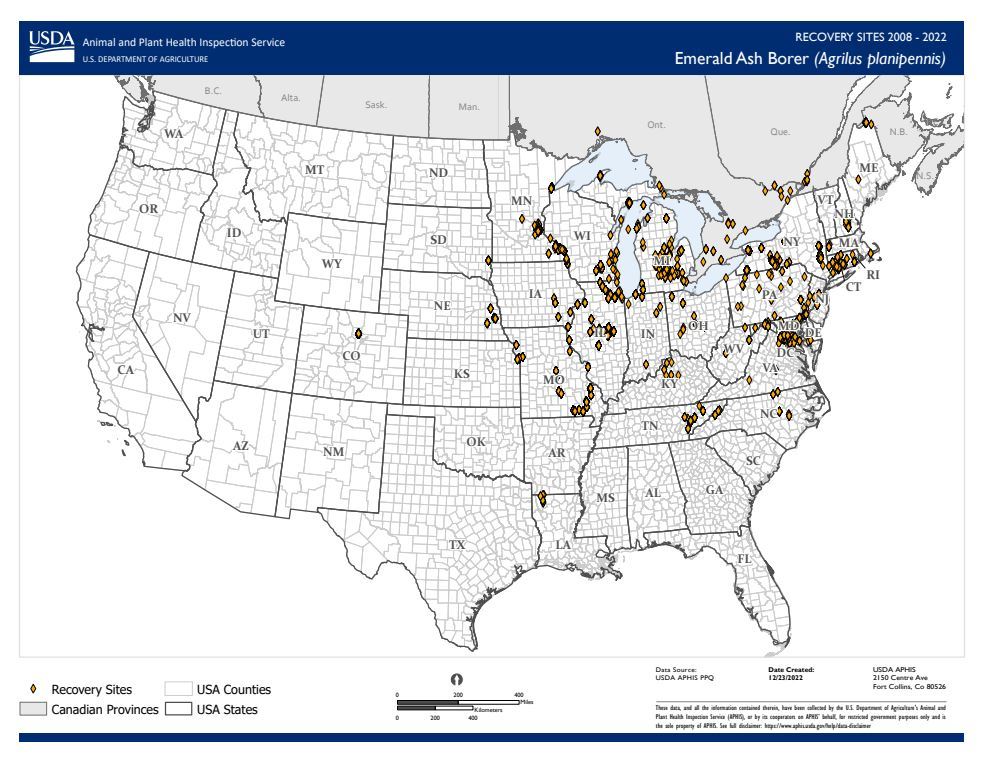USDA's Emerald Ash Borer Program Report | March 29, 2023
USDA Animal and Plant Health Inspection Service sent this bulletin at 03/29/2023 12:00 PM EDTHaving trouble viewing this email? View it as a Web page. ![]()
You are subscribed to Emerald Ash Borer Program Report for USDA Animal and Plant Health Inspection Service.

March 29, 2023
USDA’s Animal and Plant Health Inspection Service (APHIS) works with State, Federal, and other partners to detect and manage known emerald ash borer (EAB) infestations. The EAB program uses biological control and ongoing research to minimize the impact from an infestation and maintain ash as a viable part of the American landscape. This report provides the most current information on EAB program efforts.
Announcements
Enter Data by 4/30
If you are a biocontrol partner, please make sure you enter data for any release and recovery work into Map Biocontrol. Please have all data entered by April 30, 2023. If necessary, APHIS may be able to assist you with release and recovery data entries. If you have any questions or concerns, please contact Russ Bulluck directly by calling 919-855-7182 or emailing Russ.Bulluck@usda.gov.
EAB in the United States
EAB is in 36 states and the District of Columbia: Alabama, Arkansas, Colorado, Connecticut, Delaware, Georgia, Illinois, Indiana, Iowa, Kansas, Kentucky, Louisiana, Maine, Maryland, Massachusetts, Michigan, Minnesota, Missouri, Nebraska, New Hampshire, New Jersey, New York, North Carolina, Ohio, Oklahoma, Oregon, Pennsylvania, Rhode Island, South Carolina, South Dakota, Tennessee, Texas, Vermont, Virginia, West Virginia, and Wisconsin.
The image above shows where EAB biocontrol recoveries are in the United States from 2008 through 2022. Click the image or click recovery map for a closer look.
Biological Control
USDA uses emerald ash borer's natural enemies as biocontrol agents—these tiny stingless wasps are showing promise in terms of protecting young ash saplings in a number of states. To learn more about biological control and its role in protecting ash, please read Biological Control for Emerald Ash Borer. If you have additional questions, please call 1-866-322-4512 or email eab.biocontrol.program@usda.gov.
Research
APHIS scientists are studying how Integrated Pest Management (IPM) might be used in a forest ecosystem to significantly reduce and control EAB populations. IPM combines a variety of tools and strategies to identify, manage, and reduce risks and impacts from pests.
New Publication
In 2022, the U.S. Forest Service’s Contributions of Classical Biological Control to the U.S. Food Security, Forestry, and Biodiversity published a research paper titled, “Progress Toward Successful Biological Control of the Invasive Emerald Ash Borer in the United States,” which documents results from long-term field studies in Michigan and several states in the northeastern United States. The findings reveal that ash saplings and pole-size ash trees are experiencing low EAB populations because of biocontrol. Researchers and land managers are hopeful that surviving North American ash trees will be protected from EAB and ultimately become overstory trees because of biocontrol releases. To read the publication, click here.
Trapping
APHIS is providing traps and lures to conduct surveys. You can request traps, lures, and accessories through your State Plant Regulatory Official or you order them through the Integrated Plant Health Information System (IPHIS). Please remember to enter your survey data weekly into IPHIS.
Latest Maps
Infested Counties Map (Interactive)
Additional Resources
Informational Websites
EAB National Invasive Species Information Center
Outreach Materials
Contacts
EAB National Policy Manager
Ron Weeks, 919-559-4311
EAB National Operations Manager
Russ Bulluck, 919-855-7182
If you think you’ve found EAB or signs of infestation, record the area where the specimen was found and take digital pictures of the insect and tree damage. Submit your report to your State Plant Health Director, or email Report.EAB@usda.gov, or call the EAB hotline at 1-866-322-4512. Thank you.



